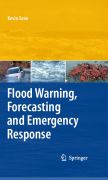
Recent flood events in Europe, the USA and elsewhere have shown the devastating impact that flooding can have on people and property. Flood warning and forecasting systems provide a well-established way to help to reduce the effects of flooding by allowing people to be evacuated from areas at risk, and for measures to be taken to reduce damage to property. With sufficient warning, temporary defences (sandbags, flood gates etc) can also be installed, and river control structures operated to mitigate the effects of flooding. Many countries and local authorities now operate some form of flood warning system, and the underlying technology requires knowledge across a range of technical areas, including rainfall and tidal detection systems, river and coastal flood forecasting models, flood warning dissemination systems, and emergency response procedures. First book providing a comprehensive summary of various topics in flood warning, forecasting and emergency response procedures Based on up-to-date research and experience gained from the implementation of operational flood forecasting and warning systems in the UK and overseas New areas are discussed, such as the use of probabilistic flood forecasts and Decision Support Systems to optimize emergency response INDICE: Preface. Acknowledgements. 1. Introduction. Part I: Flood Warning.2. Detection. 3.Thresholds. 4. Dissemination. Part II: Flood Forecasting. 5.General Principles. 6. Rivers. 7. Coastlines. 8.Selected Applications. Part III: Emergency Response. 9. Preparation. 10. Response. 11. Review. References. Glossary of Terms. Index.
- ISBN: 978-3-540-77852-3
- Editorial: Springer
- Encuadernacion: Cartoné
- Páginas: 355
- Fecha Publicación: 01/06/2008
- Nº Volúmenes: 1
- Idioma: Inglés
